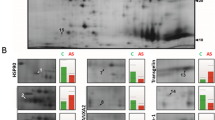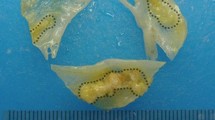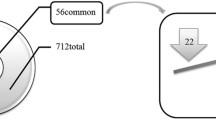Abstract
Severe aortic stenosis (AS) is prevalent in adults ≥ 65 years, a significant cause of morbidity and mortality, with no medical therapy. Lipid and proteomic alterations of human AS tissue were determined using mass spectrometry imaging (MSI) and liquid chromatography electrospray ionization tandem mass spectrometry (LC–ESI–MS/MS) to understand histopathology, potential biomarkers of disease, and progression from non-calcified to calcified phenotype. A reproducible MSI method was developed using healthy murine aortic valves (n = 3) and subsequently applied to human AS (n = 2). Relative lipid levels were spatially mapped and associated with different microdomains. Proteomics for non-calcified and calcified microdomains were performed to ascertain differences in expression. Increased pro-osteogenic and inflammatory lysophosphatidylcholine (LPC) 16:0 and 18:0 were co-localized with calcified microdomains. Proteomics analysis identified differential patterns in calcified microdomains with high LPC and low cholesterol as compared to non-calcified microdomains with low LPC and high cholesterol. Calcified microdomains had higher levels of: apolipoproteins (Apo) B-100 (p < 0.001) and Apo A-IV (p < 0.001), complement C3 and C4-B (p < 0.001), C5 (p = 0.007), C8 beta chain (p = 0.013) and C9 (p = 0.010), antithrombotic proteins alpha-2-macroglobulin (p < 0.0001) and antithrombin III (p = 0.002), and higher anti-calcific fetuin-A (p = 0.02), while the osteoblast differentiating factor transgelin (p < 0.0001), extracellular matrix proteins versican, prolargin, and lumican ( p < 0.001) and regulator protein complement factor H (p < 0.001) were higher in non-calcified microdomains. A combined lipidomic and proteomic approach provided insight into factors potentially contributing to progression from non-calcified to calcific disease in severe AS. Additional studies of these candidates and protein networks could yield new targets for slowing progression of AS.






Similar content being viewed by others
Data availability
Available upon request.
References
Angel PM, Spraggins JM, Baldwin HS, Caprioli R (2012) Enhanced sensitivity for high spatial resolution lipid analysis by negative ion mode matrix assisted laser desorption ionization imaging mass spectrometry. Anal Chem 84:1557–1564. https://doi.org/10.1021/ac202383m
Angel PM, Bayoumi AS, Hinton RB, Ru Su Y, Bichell D, Mayer JE, Scott Baldwin H, Caprioli RM (2016) Maldi imaging mass spectrometry as a lipidomic approach to heart valve research. J Heart Valve Dis 25:240–252
Bortnick AE, Rothblat GH, Stoudt G, Hoppe KL, Royer LJ, McNeish J, Francone OL (2000) The correlation of atp-binding cassette 1 mrna levels with cholesterol efflux from various cell lines. J Biol Chem 275:28634–28640. https://doi.org/10.1074/jbc.M003407200
Bortnick AE, Bartz TM, Ix JH, Chonchol M, Reiner A, Cushman M, Owens D, Barasch E, Siscovick DS, Gottdiener JS, Kizer JR (2016) Association of inflammatory, lipid and mineral markers with cardiac calcification in older adults. Heart 102:1826–1834. https://doi.org/10.1136/heartjnl-2016-309404
Brandenburg VM, Reinartz S, Kaesler N, Kruger T, Dirrichs T, Kramann R, Peeters F, Floege J, Keszei A, Marx N, Schurgers LJ, Koos R (2017) Slower progress of aortic valve calcification with vitamin k supplementation: results from a prospective interventional proof-of-concept study. Circulation 135:2081–2083. https://doi.org/10.1161/circulationaha.116.027011
Busseuil D, Shi Y, Mecteau M, Brand G, Kernaleguen AE, Thorin E, Latour JG, Rheaume E, Tardif JC (2008) Regression of aortic valve stenosis by apoa-i mimetic peptide infusions in rabbits. Br J Pharmacol 154:765–773. https://doi.org/10.1038/bjp.2008.122
Carter AM (2012) Complement activation: an emerging player in the pathogenesis of cardiovascular disease. Scientifica (Cairo) 2012:402783. https://doi.org/10.6064/2012/402783
Castro-Perez J, Hatcher N, Kofi Karikari N, Wang SP, Mendoza V, Shion H, Millar A, Shockcor J, Towers M, McLaren D, Shah V, Previs S, Akinsanya K, Cleary M, Roddy TP, Johns DG (2014) In vivo isotopically labeled atherosclerotic aorta plaques in apoe ko mice and molecular profiling by matrix-assisted laser desorption/ionization mass spectrometric imaging. Rapid Commun Mass Spectrom 28:2471–2479. https://doi.org/10.1002/rcm.7039
Chaurand P (2012) Imaging mass spectrometry of thin tissue sections: A decade of collective efforts. J Proteomics 75:4883–4892. https://doi.org/10.1016/j.jprot.2012.04.005
Chen JH, Simmons CA (2011) Cell-matrix interactions in the pathobiology of calcific aortic valve disease: Critical roles for matricellular, matricrine, and matrix mechanics cues. Circ Res 108:1510–1524. https://doi.org/10.1161/circresaha.110.234237
Chiyoya M, Seya K, Yu Z, Daitoku K, Motomura S, Imaizumi T, Fukuda I, Furukawa KI (2018) Matrix gla protein negatively regulates calcification of human aortic valve interstitial cells isolated from calcified aortic valves. J Pharmacol Sci 136:257–265. https://doi.org/10.1016/j.jphs.2018.03.004
Coutu DL, Wu JH, Monette A, Rivard GE, Blostein MD, Galipeau J (2008) Periostin, a member of a novel family of vitamin k-dependent proteins, is expressed by mesenchymal stromal cells. J Biol Chem 283:17991–18001. https://doi.org/10.1074/jbc.M708029200
Di Lullo L, Tripepi G, Ronco C, D’Arrigo G, Barbera V, Russo D, Di Iorio BR, Uguccioni M, Paoletti E, Ravera M, Fusaro M, Bellasi A (2019) Cardiac valve calcification and use of anticoagulants: preliminary observation of a potentially modifiable risk factor. Int J Cardiol 278:243–249. https://doi.org/10.1016/j.ijcard.2018.11.119
Elsafadi M, Manikandan M, Dawud RA, Alajez NM, Hamam R, Alfayez M, Kassem M, Aldahmash A, Mahmood A (2016) Transgelin is a tgfbeta-inducible gene that regulates osteoblastic and adipogenic differentiation of human skeletal stem cells through actin cytoskeleston organization. Cell Death Dis 7:e2321. https://doi.org/10.1038/cddis.2016.196
Furtado JD, Yamamoto R, Melchior JT, Andraski AB, Gamez-Guerrero M, Mulcahy P, He Z, Cai T, Davidson WS, Sacks FM (2018) Distinct proteomic signatures in 16 hdl (high-density lipoprotein) subspecies. Arterioscler Thromb Vasc Biol 38:2827–2842. https://doi.org/10.1161/atvbaha.118.311607
Helske S, Oksjoki R, Lindstedt KA, Lommi J, Turto H, Werkkala K, Kupari M, Kovanen PT (2008) Complement system is activated in stenotic aortic valves. Atherosclerosis 196:190–200. https://doi.org/10.1016/j.atherosclerosis.2007.03.040
Karlsson O, Bergquist J, Andersson M (2014) Quality measures of imaging mass spectrometry aids in revealing long-term striatal protein changes induced by neonatal exposure to the cyanobacterial toxin beta-n-methylamino-l-alanine (bmaa). Mol Cell Proteomics 13:93–104. https://doi.org/10.1074/mcp.M113.031435
Kind T, Liu KH, Lee DY, DeFelice B, Meissen JK, Fiehn O (2013) Lipidblast in silico tandem mass spectrometry database for lipid identification. Nat Methods 10:755–758. https://doi.org/10.1038/nmeth.2551
Kochtebane N, Choqueux C, Passefort S, Nataf P, Messika-Zeitoun D, Bartagi A, Michel JB, Anglés-Cano E, Jacob MP (2010) Plasmin induces apoptosis of aortic valvular myofibroblasts. J Pathol 221:37–48. https://doi.org/10.1002/path.2681
Koos R, Brandenburg V, Mahnken AH, Muhlenbruch G, Stanzel S, Gunther RW, Floege J, Jahnen-Dechent W, Kelm M, Kuhl HP (2009) Association of fetuin-a levels with the progression of aortic valve calcification in non-dialyzed patients. Eur Heart J 30:2054–2061. https://doi.org/10.1093/eurheartj/ehp158
Krohn JB, Hutcheson JD, Martínez-Martínez E, Aikawa E (2016) Extracellular vesicles in cardiovascular calcification: expanding current paradigms. J Physiol 594:2895–2903. https://doi.org/10.1113/JP271338
Kubota N, Testuz A, Boutten A, Robert T, Codogno I, Duval X, Tubiana S, Hekimian G, Arangalage D, Cimadevilla C, Kerneis C, Vahanian A, Messika-Zeitoun D (2018) Impact of fetuin-a on progression of calcific aortic valve stenosis—the cofrasa-generac study. Int J Cardiol 265:52–57. https://doi.org/10.1016/j.ijcard.2018.03.070
Liebisch G, Drobnik W, Lieser B, Schmitz G (2002) High-throughput quantification of lysophosphatidylcholine by electrospray ionization tandem mass spectrometry. Clin Chem 48:2217–2224. http://clinchem.aaccjnls.org/content/clinchem/48/12/2217.full.pdf
Lindman BR, Clavel MA, Mathieu P, Iung B, Lancellotti P, Otto CM, Pibarot P (2016) Calcific aortic stenosis. Nat Rev Dis Primers 2:16006. https://doi.org/10.1038/nrdp.2016.6
Lou X, van Dongen JL, Vekemans JA, Meijer EW (2009) Matrix suppression and analyte suppression effects of quaternary ammonium salts in matrix-assisted laser desorption/ionization time-of-flight mass spectrometry: an investigation of suppression mechanism. Rapid Commun Mass Spectrom 23:3077–3082. https://doi.org/10.1002/rcm.4224
Mahmut A, Boulanger MC, El Husseini D, Fournier D, Bouchareb R, Despres JP, Pibarot P, Bosse Y, Mathieu P (2014) Elevated expression of lipoprotein-associated phospholipase a2 in calcific aortic valve disease: implications for valve mineralization. J Am Coll Cardiol 63:460–469. https://doi.org/10.1016/j.jacc.2013.05.105
Martin-Rojas T, Mourino-Alvarez L, Alonso-Orgaz S, Rosello-Lleti E, Calvo E, Lopez-Almodovar LF, Rivera M, Padial LR, Lopez JA, de la Cuesta F, Barderas MG (2015) Itraq proteomic analysis of extracellular matrix remodeling in aortic valve disease. Sci Rep 5:17290. https://doi.org/10.1038/srep17290
Mourino-Alvarez L, Iloro I, de la Cuesta F, Azkargorta M, Sastre-Oliva T, Escobes I, Lopez-Almodovar LF, Sanchez PL, Urreta H, Fernandez-Aviles F, Pinto A, Padial LR, Akerstrom F, Elortza F, Barderas MG (2016) Maldi-imaging mass spectrometry: a step forward in the anatomopathological characterization of stenotic aortic valve tissue. Sci Rep 6:27106. https://doi.org/10.1038/srep27106
Murphy RC, Hankin JA, Barkley RM (2009) Imaging of lipid species by maldi mass spectrometry. J Lipid Res. https://doi.org/10.1194/jlr.R800051-JLR200
Natorska J, Undas A (2015) Blood coagulation and fibrinolysis in aortic valve stenosis: links with inflammation and calcification. Thromb Haemost 114:217–227. https://doi.org/10.1160/TH14-10-0861
Pawade T, Clavel MA, Tribouilloy C, Dreyfus J, Mathieu T, Tastet L, Renard C, Gun M, Jenkins WSA, Macron L, Sechrist JW, Lacomis JM, Nguyen V, Galian Gay L, Cuellar Calabria H, Ntalas I, Cartlidge TRG, Prendergast B, Rajani R, Evangelista A, Cavalcante JL, Newby DE, Pibarot P, Zeitoun M, D and Dweck MR (2018) Computed tomography aortic valve calcium scoring in patients with aortic stenosis. Circ Cardiovasc Imaging 11:e007146. https://doi.org/10.1161/circimaging.117.007146
Rajamannan NM, Evans FJ, Aikawa E, Grande-Allen KJ, Demer LL, Heistad DD, Simmons CA, Masters KS, Mathieu P, O’Brien KD, Schoen FJ, Towler DA, Yoganathan AP, Otto CM (2011) Calcific aortic valve disease: not simply a degenerative process: a review and agenda for research from the national heart and lung and blood institute aortic stenosis working group. Executive summary: calcific aortic valve disease-2011 update. Circulation 124:1783–1791. https://doi.org/10.1161/circulationaha.110.006767
Rattazzi M, Faggin E, Bertacco E, Nardin C, Pagliani L, Plebani M, Cinetto F, Guidolin D, Puato M, Pauletto P (2018) Warfarin, but not rivaroxaban, promotes the calcification of the aortic valve in apoe-/- mice. Cardiovasc Ther 36:e12438. https://doi.org/10.1111/1755-5922.12438
Romagnuolo R, Marcovina SM, Boffa MB, Koschinsky ML (2014) Inhibition of plasminogen activation by apo(a): role of carboxyl-terminal lysines and identification of inhibitory domains in apo(a). J Lipid Res 55:625–634. https://doi.org/10.1194/jlr.M036566
Rossmann B, Luf TK W (2007) Ms-ms fragmentation patterns of cholesterol oxidation products. Monatshefte Fur Chemie 138:436–444. https://doi.org/10.1007/s00706-007-0589-2
Sarma JV, Ward PA (2011) The complement system. Cell Tissue Res 343:227–235. https://doi.org/10.1007/s00441-010-1034-0
Satoh K, Yamada K, Maniwa T, Oda T, Matsumoto K (2015) Monitoring of serial presurgical and postsurgical changes in the serum proteome in a series of patients with calcific aortic stenosis. Dis Mark 2015:694120. https://doi.org/10.1155/2015/694120
Schafer C, Heiss A, Schwarz A, Westenfeld R, Ketteler M, Floege J, Muller-Esterl W, Schinke T, Jahnen-Dechent W (2003) The serum protein alpha 2-heremans-schmid glycoprotein/fetuin-a is a systemically acting inhibitor of ectopic calcification. J Clin Invest 112:357–366. https://doi.org/10.1172/jci17202
Schiller J, Zschornig O, Petkovic M, Muller M, Arnhold J, Arnold K (2001) Lipid analysis of human hdl and ldl by maldi-tof mass spectrometry and (31)p-nmr. J Lipid Res 42:1501–1508
Schlotter F, Halu A, Goto S, Blaser MC, Body SC, Lee LH, Higashi H, DeLaughter DM, Hutcheson JD, Vyas P, Pham T, Rogers MA, Sharma A, Seidman CE, Loscalzo J, Seidman JG, Aikawa M, Singh SA, Aikawa E (2018) Spatiotemporal multi-omics mapping generates a molecular atlas of the aortic valve and reveals networks driving disease. Circulation 138:377–393. https://doi.org/10.1161/circulationaha.117.032291
Schmitz G, Ruebsaamen K (2010) Metabolism and atherogenic disease association of lysophosphatidylcholine. Atherosclerosis 208:10–18. https://doi.org/10.1016/j.atherosclerosis.2009.05.029
Schoengraf P, Lambris JD, Recknagel S, Kreja L, Liedert A, Brenner RE, Huber-Lang M, Ignatius A (2013) Does complement play a role in bone development and regeneration? Immunobiology 218:1–9. https://doi.org/10.1016/j.imbio.2012.01.020
Smith JG, Luk K, Schulz CA, Engert JC, Do R, Hindy G, Rukh G, Dufresne L, Almgren P, Owens DS, Harris TB, Peloso GM, Kerr KF, Wong Q, Smith AV, Budoff MJ, Rotter JI, Cupples LA, Rich S, Kathiresan S, Orho-Melander M, Gudnason V, O’Donnell CJ, Post WS, Thanassoulis G (2014) Association of low-density lipoprotein cholesterol-related genetic variants with aortic valve calcium and incident aortic stenosis. JAMA 312:1764–1771. https://doi.org/10.1001/jama.2014.13959
Stegemann C, Drozdov I, Shalhoub J, Humphries J, Ladroue C, Didangelos A, Baumert M, Allen M, Davies AH, Monaco C, Smith A, Xu Q, Mayr M (2011) Comparative lipidomics profiling of human atherosclerotic plaques. Circ Cardiovasc Genet 4:232–242. https://doi.org/10.1161/CIRCGENETICS.110.959098
Thanassoulis G, Campbell CY, Owens DS, Smith JG, Smith AV, Peloso GM, Kerr KF, Pechlivanis S, Budoff MJ, Harris TB, Malhotra R, O’Brien KD, Kamstrup PR, Nordestgaard BG, Tybjaerg-Hansen A, Allison MA, Aspelund T, Criqui MH, Heckbert SR, Hwang SJ, Liu Y, Sjogren M, van der Pals J, Kalsch H, Muhleisen TW, Nothen MM, Cupples LA, Caslake M, Di Angelantonio, E, Danesh, J, Rotter, JI, Sigurdsson S, Wong Q, Erbel R, Kathiresan S, Melander O, Gudnason V, O’Donnell CJ, Post WS (2013) Genetic associations with valvular calcification and aortic stenosis. N Engl J Med 368:503–512. https://doi.org/10.1056/NEJMoa1109034
Thomas A, Charbonneau JL, Fournaise E, Chaurand P (2012) Sublimation of new matrix candidates for high spatial resolution imaging mass spectrometry of lipids: enhanced information in both positive and negative polarities after 1,5-diaminonapthalene deposition. Anal Chem 84:2048–2054. https://doi.org/10.1021/ac2033547
Thukkani AK, McHowat J, Hsu FF, Brennan ML, Hazen SL, Ford DA (2003) Identification of alpha-chloro fatty aldehydes and unsaturated lysophosphatidylcholine molecular species in human atherosclerotic lesions. Circulation 108:3128–3133. https://doi.org/10.1161/01.CIR.0000104564.01539.6A
Vickers KC, Castro-Chavez F, Morrisett JD (2010) Lyso-phosphatidylcholine induces osteogenic gene expression and phenotype in vascular smooth muscle cells. Atherosclerosis 211:122–129. https://doi.org/10.1016/j.atherosclerosis.2010.04.005
Viney NJ, van Capelleveen JC, Geary RS, Xia S, Tami JA, Yu RZ, Marcovina SM, Hughes SG, Graham MJ, Crooke RM, Crooke ST, Witztum JL, Stroes ES, Tsimikas S (2016) Antisense oligonucleotides targeting apolipoprotein(a) in people with raised lipoprotein(a): two randomised, double-blind, placebo-controlled, dose-ranging trials. Lancet 388:2239–2253. https://doi.org/10.1016/s0140-6736(16)31009-1
Yasojima K, Schwab C, McGeer EG, McGeer PL (2001a) Generation of c-reactive protein and complement components in atherosclerotic plaques. Am J Pathol 158:1039–1051. https://doi.org/10.1016/s0002-9440(10)64051-5
Yasojima K, Schwab C, McGeer EG, McGeer PL (2001b) Complement components, but not complement inhibitors, are upregulated in atherosclerotic plaques. Arterioscler Thromb Vasc Biol 21:1214–1219. http://atvb.ahajournals.org/content/atvbaha/21/7/1214.full.pdf
Yoder M, Zhuge Y, Yuan Y, Holian O, Kuo S, van Breemen R, Thomas LL, Lum H (2014) Bioactive lysophosphatidylcholine 16:0 and 18:0 are elevated in lungs of asthmatic subjects. Allergy Asthma Immunol Res 6:61–65. https://doi.org/10.4168/aair.2014.6.1.61
Youssef A, Clark JR, Koschinsky ML, Boffa MB (2020) Lipoprotein(a): expanding our knowledge of aortic valve narrowing. Trends Cardiovasc Med. https://doi.org/10.1016/j.tcm.2020.06.001
Zaima N, Sasaki T, Tanaka H, Cheng XW, Onoue K, Hayasaka T, Goto-Inoue N, Enomoto H, Unno N, Kuzuya M, Setou M (2011) Imaging mass spectrometry-based histopathologic examination of atherosclerotic lesions. Atherosclerosis 217:427–432. https://doi.org/10.1016/j.atherosclerosis.2011.03.044
Zhao Y, Nicoll R, He YH, Henein MY (2016) The effect of statins on valve function and calcification in aortic stenosis: a meta-analysis. Atherosclerosis 246:318–324. https://doi.org/10.1016/j.atherosclerosis.2016.01.023
Acknowledgements
We acknowledge Edward Nieves’ assistance with mass spectrometry, Amanda Beck, Jeffrey Harding and Barbara Canella’s assistance in sectioning and photomicrography (all from the Montefiore Health System and Albert Einstein College of Medicine). We thank Genevieve T. Aguilan for composing Fig. 1.
Funding
Funded by the Department of Medicine, Division of Cardiology at Montefiore Health System and Albert Einstein College of Medicine, with additional support from American Heart Association Mentored Clinical and Population Award 17MCPRP33630098, the Empire Clinical Research Investigator Program, and National Institutes of Health 1K23HL146982-01A1 (AEB), National Institutes of Health UL1TR001073, National Institutes of Health 1S10RR025128 and Shared Instrumentation Grant 1S10RR029398-01 (RHA).
Author information
Authors and Affiliations
Contributions
JL, JA, LMW, RHA, AEB: conception and design, collection and assembly of data, and data analysis and interpretation, manuscript writing, manuscript editing and final approval of manuscript; RS, FN: collection and assembly of data and final approval of manuscript.
Corresponding author
Ethics declarations
Conflict of interest
AEB served as site principal investigator for multi-center trials sponsored by Abbott and CSL-Behring in the past year, for which her institution received compensation and received an honorarium from ClearView Healthcare Partners, LLC.
Additional information
Publisher's Note
Springer Nature remains neutral with regard to jurisdictional claims in published maps and institutional affiliations.
Electronic supplementary material
Below is the link to the electronic supplementary material.
Rights and permissions
About this article
Cite this article
Lim, J., Aguilan, J.T., Sellers, R.S. et al. Lipid mass spectrometry imaging and proteomic analysis of severe aortic stenosis. J Mol Hist 51, 559–571 (2020). https://doi.org/10.1007/s10735-020-09905-5
Received:
Accepted:
Published:
Issue Date:
DOI: https://doi.org/10.1007/s10735-020-09905-5




